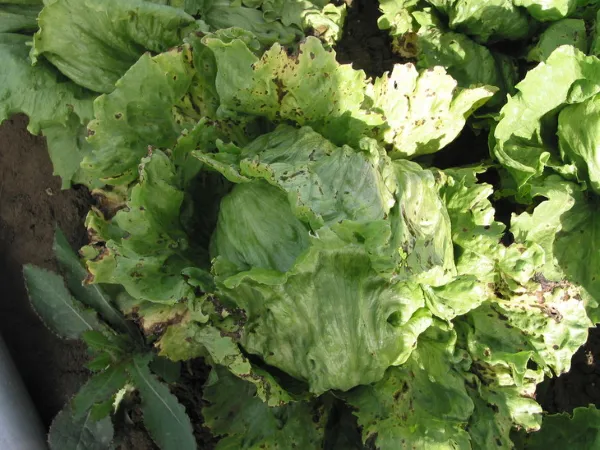Plant pathologists in Penn State’s College of Agricultural Sciences are lending their expertise to a multi-institutional research project designed to stop a destructive bacterial disease in lettuce.
The project, which is being led by the University of Florida’s Institute of Food and Agricultural Sciences, will focus on plant breeding and genetic approaches to study disease resistance and the various interactions between lettuce and bacterial leaf spot of lettuce, which is caused by the pathogen Xanthomonas campestris pv. vitians.

Bacterial leaf spot of lettuce causes dark lesions to form on leaves, thereby reducing product quality. Image: Carolee Bull
The disease causes dark lesions to form on leaves, thereby reducing product quality, noted Carolee Bull, professor and head of the Department of Plant Pathology and Environmental Microbiology at Penn State.
“Bacterial leaf spot disease is known for its unpredictability because it does not occur every year or in every field,” said Bull. “But severe outbreaks can destroy entire fields quickly, causing significant economic losses for growers, which could lead to higher prices for consumers.”
The disease threatens the $2 billion lettuce industry in the U.S., especially growers in California, Arizona and Florida, the states that account for most of the production. Agricultural operations from other regions that rely on lettuce as part of diverse farm operations are impacted too, Bull pointed out, including more than 460 growers in Pennsylvania.
Currently, there is no meaningful control method for bacterial leaf spot disease, according to principal investigator Germán V. Sandoya-Miranda, assistant professor of lettuce breeding and genetics at the University of Florida’s Everglades Research and Education Center.
“This is the first time that experts in plant breeding, genetics, bacteriology and weed science are partnering to develop sustainable and long-term solutions to battle an unpredictable and devastating disease in lettuce,” said Sandoya-Miranda, who studied plant breeding for biotic stresses as a postdoctoral scholar at Penn State.
“I intentionally have brought together the leading experts representing the strongest possible group to work on this disease for a variety of geographic impacted areas and assorted farm-size growers,” he said.
Another of those experts is Maria Gorgo-Gourovitch, Penn State Extension horticulture educator and affiliate instructor in the Department of Plant Pathology and Environmental Microbiology. In addition to supporting the experiments, she will ensure that knowledge gained from the project is shared through bilingual extension products in keeping with Penn State’s Latinx agricultural initiatives.
Emma Rosenthal, a doctoral candidate in plant pathology working in Bull's lab, also has been invited to join the team. Her research interests focus on plant-pathogen interactions and developing methods for detecting and quantifying strains of pathogens that cause disease in crops.
The USDA Agricultural Research Service's Crop Improvement and Protection Research Unit in Salinas, California, where Bull served as a research plant pathologist for 20 years before joining Penn State, is a project partner. Scientists there will identify resistance genes in cultivated and wild accessions of lettuce and introduce these genes into the breeding program.
“I am delighted to have been invited to work with this team of experts and excited to be working again with my former colleagues from the USDA/ARS,” said Bull, who worked with Sandoya-Miranda at the Salinas facility. “My whole team and especially Ms. Rosenthal will benefit from this broad perspective.”
The University of Florida received a USDA Specialty Crop Multi-State Program grant of $850,816 to support this research.
Source: Penn State
